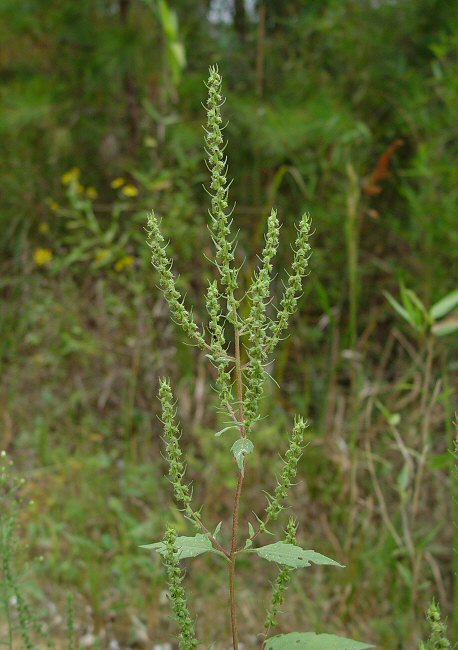Iva annua L.
Marsh Elder

Native
CC = 1
CW = 0
MOC = 50
© DETenaglia
Iva annua L.Marsh Elder | |
 |
Native CC = 1 CW = 0 MOC = 50 |
© DETenaglia |
|
Family - Asteraceae/Heliantheae Habit - Taprooted annual forb.
Stems - Ascending to erect, to 1.2 m, usually several-branched, finely ridged or grooved, sparsely to moderately roughened with short, ascending, pustular-based hairs, often also with longer, spreading hairs toward the tip, usually glabrous or nearly so toward the base.
Leaves - Opposite or the uppermost few alternate, simple, sessile to long-petiolate. Leaf blades 2-15 cm long, lanceolate to broadly ovate, angled or short-tapered at the base, tapered at the sharply pointed tip, the margins entire or toothed and hairy, the surfaces nearly glabrous to sparsely or moderately roughened with short, somewhat appressed hairs, often also with sparse, longer, spreading hairs along the main veins and/or near the base, usually also sparsely to moderately gland-dotted.
Inflorescence - Spikelike racemes terminal on the branch tips, these sometimes appearing paniculate, the heads very short-stalked, solitary at the nodes, subtended by ovate to narrowly lanceolate, leaflike bracts.
Heads - Discoid, pendent. Involucre 2-4 mm long, cup-shaped, somewhat asymmetrical, the 3-5 involucral bracts in 1 series, fused irregularly near the base, green, sparsely long-hairy, especially along the margins. Receptacle flat, with chaffy bracts subtending the florets, these narrowly linear to narrowly oblanceolate, usually glandular along the margins, not wrapped around the florets.
Florets - Central florets 9-16, staminate, with a minute, nonfunctional ovary and undivided style, the stamens with the filaments more or less fused into a tube and the anthers free but positioned closely adjacent to one another in a ring, the corolla 2.0-2.5 mm long, funnelform to narrowly bell-shaped, 5-lobed, white to pale yellow, sometimes purplish-tinged toward the tip, usually glabrous. Marginal florets 3-5, pistillate, the corolla 1.0-1.5 mm long, narrowly tubular, often slightly oblique but unlobed at the tip, white to pale yellow, often persistent at fruiting. Pappus of the staminate and pistillate florets absent. Ray florets absent.
Fruits - Achenes 2.5-4.0 mm long, broadly obovoid, somewhat flattened, not angled or at most very bluntly angled on 1 face, otherwise appearing smooth or with numerous faint, fine longitudinal lines, brown to dark brown, glabrous but with minute, sessile glands.
Flowering - July - October. Habitat - Streambanks, pond margins, swamps, sloughs, bottomlands, moist swales, fields, pastures, railroads, roadsides, and open, disturbed areas. Origin - Native to the U.S. Lookalikes - Some species of Ambrosia. Other info. - This weedy-appearing species occurs throughout most of Missouri, but is less common or absent in the northwest portion of the state and the central Ozarks. Its U.S. distribution is mainly central-southern. The plant can be identified by its ovate-triangular leaves, inflorescences with conspicuous bracts, and pubescent stems. This species produces copious amounts of air-borne pollen which is a major cause of hay fever in the fall. A form of the plant with relatively large fruits was once cultivated by prehistoric peoples, apparently as a grain or medicinal crop. The plants can be grown in dense stands and the "seeds" can be easily harvested by hand. However, the plants have negative attributes, such as being malodorous and highly allergenic. Over time, this cultivated form was gradually displaced by more favorable crops such as maize, and is now extinct. Photographs taken off Macon County Road 43, Macon County, AL., 10-9-04 (DETenaglia); also at Marais Temps Clair Conservation Area, St. Charles County, MO, 9-23-2010, and along Missouri River floodplain near I-70, St. Louis County, MO 9-7-2017 (SRTurner). |